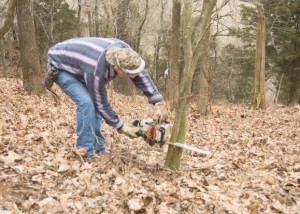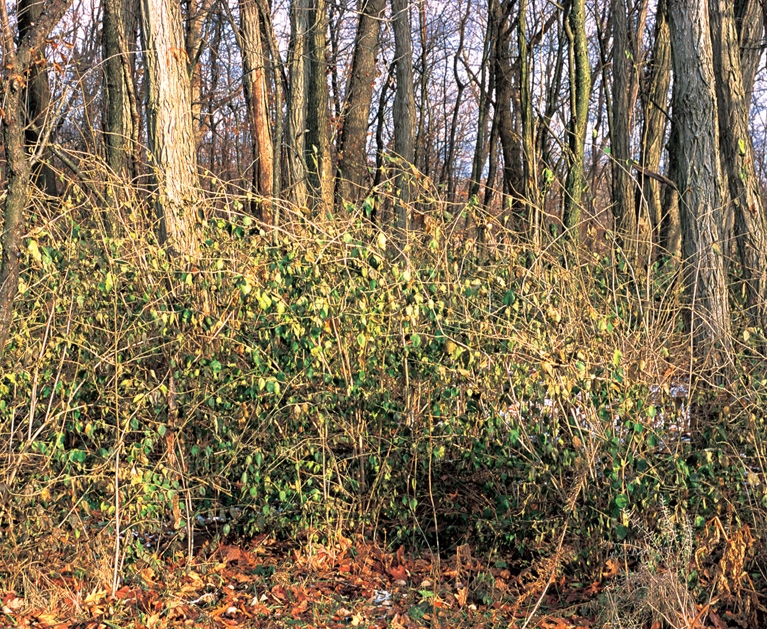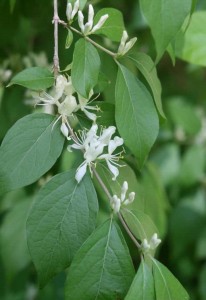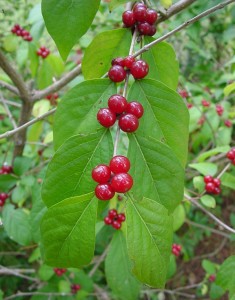Bush Honeysuckle is Foreign Enemy # 1 for Bluff Lands’ Health
Bush honeysuckle is foreign enemy number one in our blufflands. It has taken over the understory in many areas of the woods, is destroying our natural habitats, and is transforming forever our natural landscape.
While the several types of Asian bush honeysuckles present in the U.S. do have differences which separate them into species, all have the same basic story of importation for apparently “good” purposes with unintended and dramatically bad results. Viewed as sweet-smelling, pretty shrubs, bush honeysuckles were imported first to Europe in 1855 and then introduced to the Eastern U.S. in 1896. Widely sold as ornamental plantings, bush honeysuckles also were recommended for additional seemingly beneficial purposes. Since deer browse the vegetation and birds and small mammals eat the prolific red berries, bush honeysuckles were viewed as excellent wildlife plantings, and, because the plants form dense colonies due to root suckering, they also were promoted as a way to control soil erosion.
But these two qualities — tremendous seed production and root generation — coupled with a total lack of controlling predators or diseases in U.S. lands, allowed bush honeysuckles to become one of the most invasive plants on our landscape. As recently as 30 years ago, bush honeysuckles were not known to grow in our area of the state. Time-lapse maps of invasive species show a steady and speedy movement of these plants out of urban areas and into all parts of Illinois.
Bush honeysuckle forms understory thickets which shade out and crowd out the natural regeneration of our native plants. Large colonies of bush honeysuckle are easily viewed along Route 3, especially at wooded areas near Columbia and Waterloo, along Bluff Road, and, sadly, at nearly any wooded area. The totality of impact is dramatic, for once a bush honeysuckle thicket has formed, few other plants are able to grow and reproduce. Bush honeysuckle, like many exotic invasives, creates a monoculture of itself, alone, and transforms a landscape into a desert that gives little sustenance.
Our native oaks and hickories can no longer generate new seedling growth due to the deep shade. New trees and the future acorn and nut production are therefore reduced. Deer, turkey, quail and a host of other critters that depend on acorns and nuts for food simply run out of food and, where possible, move on, sometimes to adjacent woods and sometimes into yards and gardens. Native wildflowers are shaded out and, lacking enough sunlight to bloom and set seeds, simply die out. Similarly, our native morels and mushrooms cannot maintain colonies without healthy oak-hickory forest areas on which to spread their spores, and are gone forever.
Bush honeysuckle is easily recognized. In fall, its leaves remain green long after
native trees and shrubs have dropped their leaves. In spring, bush honeysuckle greens up and leafs out before our native trees and shrubs do. Their ability to green-up earlier and stay green longer gives these invaders an eight to ten week longer growing season — another adaptive advantage which makes bush honeysuckle out-compete our native plants.
Bush honeysuckle is an erect, multi-stemmed semi-evergreen/deciduous shrub with arching branches that can grow 10-20 feet tall. Its leaves are opposite, untoothed, oblong tapering at the tips, and 2-3” long. Fragrant tubular flowers appear in spring and age from white to yellow.
Bush honeysuckle berries are red, 1/4 inch in diameter, and appear in May-June. Birds and small mammals eat the berries and help spread the invaders as the seeds are evacuated far from the original plant. Migratory birds, in fact, are the prime culprits in bringing the honeysuckle into our area of the state. The berries, however, are low in fat content compared to our native berries, and provide low food value to our game and non-game birds.
There is a simple, surefire field test for ensuring you have identified bush honeysuckle and not confused it with one of our beneficial native plants. Simply cut off a woody twig or branchlet with a scissors or a knife. Bush honeysuckle has a hollow pith; our native good guys do not.
There are several management techniques to control and eliminate bush honeysuckle. Smaller specimens, 2 or less feet high, can be easily pulled by two hands. Weed-pullers should take care to disturb the soil as little as possible, since seeds may already be present, and, if berries are on the pulled bushes, the pulled plants should be bagged and removed from the area.
Herbicides are effective in controlling bush honeysuckle. Foliar spraying may be the best method for large-scale, heavy infestations. Use a systemic herbicide such as glyphosate (Roundup) or triclopyr (Garlon, Crossbow) in the manufacturer’s recommended dilution strength, adding surfactant if recommended. Thoroughly wet all the honeysuckles’ leaves. This method is most effective in late September through early November.
The downside of this method is potential collateral damage to other desirable plants and contamination of the watershed. Herbicide drift may kill plants close by. If you use too much of the herbicide, the toxins may pass through the honeysuckles’ roots into the roots of nearby desirable non-target native plants. You need to avoid using herbicides near creeks, wetlands, sink hole ponds, and the watershed in general. And, foliar spraying does not affect any seeds present on the plants. Finally, the foliar spray method uses the largest amount of expensive herbicide.
An alternate method to eradicate bush honeysuckle is a combination of manual and chemical practices. It’s also the most work, but will guarantee success with existing colonies of bush honeysuckle.
Simply cut the bush honeysuckle shrubs down to the lowest possible common stem(s) near the ground and then immediately paint, daub or squirt herbicide on the cut stump. Don’t wait to apply the herbicide, because the stump can scab over in less than an hour which prevents herbicide penetration. This method is also most effective in the late September – early November timeframe because sap is moving down to the roots and will help carry the herbicide. Again, any dead bushes with berries should be carefully removed from the area to prevent seed spread.
Finally, bush honeysuckle cannot tolerate fire. But our native oaks and hickories thrive on fire. A prescribed and controlled burn of your woods in late fall or winter will go a long way in managing honeysuckle. Just make certain you conduct a burn in accordance with Illinois’ new Prescribed Burn Law.
Full control and eradication of a bush honeysuckle thicket is a multiyear tasking. Unfortunately the seeds can remain viable within the soil for several years and, more unfortunately still, seeds from plants in other areas can still be transported into the area you’ve worked so hard to clear of this tenacious invader.

Martin Kemper, Illinois Department of Natural Resources. A Clifftop volunteer cuts a large bush honeysuckle.
So, if you’re looking for a real diversion this fall, and want to protect our precious natural heritage, go out to your woodlands and attack bush honeysuckle.
Clifftop, a local nonprofit organization, is focused on preserving and protecting area blufflands.
A version of this article appeared in the September 10 2008 edition of the Monroe County Clarion.
© 2008 all content rights reserved, Clifftop NFP.
Comments are currently closed.



